There are plenty of free online courses to advance your design skills in a variety of areas.
Here is a list of helpful design courses. There are courses on design thinking, web design, graphic design, user experience design, logo design, color theory, and more. Some of the courses are multi-class programs, while others are short tutorials. All of the courses are free, though several courses offer premium options for additional access and accreditation.
Free Design Courses
Introduction to Design Systems. Learn how to create, use, and implement a visual design system, similar to Google’s “Material Design” or Adobe’s “Spectrum.” Improve your organization’s efficiency and consistency by adhering to a set of predefined components and principles.
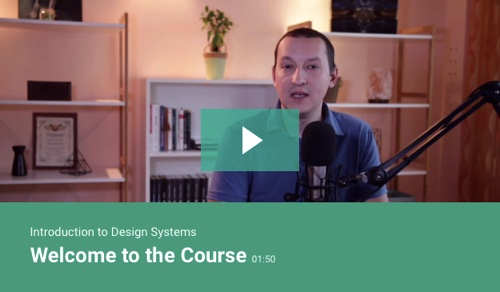
Introduction to Design Systems
Design Thinking. This course will teach you to think like a designer, with steps for creating and testing new ideas. Explore people-centered design and problem discovery, the seven mindsets for designers, and design research and analysis. Learn storyboarding, prototyping, and usability testing to develop your designs.
Web Design for Everybody: Basics of Web Development & Coding Specialization. This is a five-course specialization offered by the University of Michigan in which students learn to design and implement a responsive site for a minimum of three platforms. The specialization starts with an introduction to HTML5, CSS3, and JavaScript and then explores advanced styling with responsive design.
Web Design for Web Developers. This hour-long on-demand video provides 25-plus guidelines for achieving exceptional web design. Explore visual hierarchy, color, graphic imagery, textography, and more. Learn simple design techniques to make your websites convert better.
Visual Web Design Mastery. Learn web design by watching a designer at work. In this series of five videos, watch as five home pages are created, from start to finish, for five businesses. There’s also a 139-page ebook that explains the concepts in the videos.
Introduction to Graphic Design. This is the first course of a two-part program called Graphic Design History and Methods. Learn the origins of text and graphic design, the development of practical graphic design through modernist art movements, design across world languages, and more.
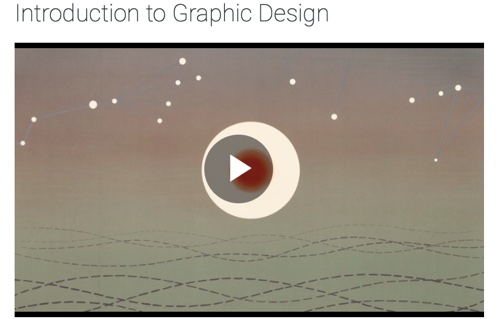
Introduction to Graphic Design
Graphic Design Basics. Part of Canva’s Design School, this course is a series of twelve quick lessons on design, including color wheel basics, fonts, tints, and shading.
Applying Design Principles. Learn core graphic design principles and their practical applications through a study of successful designs. Explore composition and balance, contrast and hierarchy, color, shapes, tones, and more. By the end of this course, you’ll understand design concepts and the ability to apply the lessons to your designs.
Graphic Design Basics: Core Principles for Visual Design. This 35-minute course covers the five basic principles of graphic design: symmetry, scale, framing, hierarchy, and grids. Learn to critique your projects for effectiveness and balance, and apply core concepts in future projects.
Graphic Design Specialization. From the California Institute of the Arts, this four-course sequence explores the fundamentals of graphic design: images, typography, composition, color, and shape. Also, explore the ideas from the history of graphic design, and trace the emergence of design as a recognized practice.
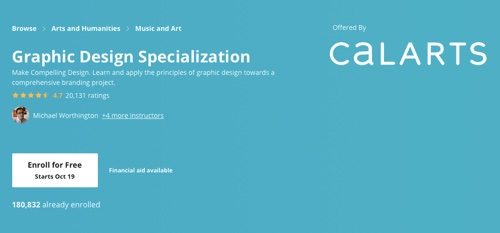
Graphic Design Specialization
Logo Design Fundamentals. In this hour-long course, learn how to create and build a unique logo design using Adobe Illustrator and Photoshop.
An Introduction to Typeface Styles. In this short course, explore the differences in typeface styles and sub-types. Learn which to use and when.
Color for Designers. Learn the principles of color theory along with practical lessons on how to apply them. The course covers color terminology and meaning, viewing color in context, contrast grids, color illusion, and tips for creating a harmonious color palette.
UX Methods Fundamentals. This hour-long course explores five user experience design methods and processes: Design Thinking, User-Centered Design, Agile UX, Lean UX, and Behavioral Design Process. Compare UX methods, and find the right system to develop your optimal user experience design.
Fast and Effective UX Design: Learn the Process. Here is another short course to learn the user experience process. Design veteran Jose Caballer demonstrates how to facilitate UX design in a live session with a client, moving from goal-setting to user profiles to wireframe design, sharing tips and ready-to-use templates.
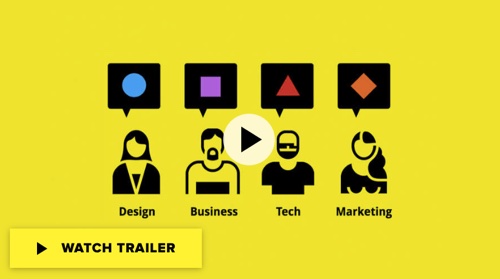
Fast and Effective UX Design
Responsive Web Design Fundamentals. Learn the fundamentals of responsive web design with Google’s Pete LePage. Explore what makes a site responsive and how some common responsive design patterns work across different devices. Create your own responsive layout using the viewport tag and CSS media queries, and experiment with major and minor breakpoints, and optimizing text for reading.
Web Design: Learn to Build a Responsive Website in 3 Hours. Learn the 12 steps to building a responsive mobile-friendly website, with no coding and no web design experience required. Design your website in under three hours.
Responsive Web Design with HTML5 and CSS3 – Advanced. If you have been building responsive websites and you’re ready to take your skills to the next level, then this course is for you. It’s the third course in the series on responsive web design. It covers building web pages with CSS preprocessor, PHP, Foundation 5 CSS framework, and jQuery Mobile.
Of Course You Can!: The Ultimate Graphic and Web Design Course. This course features nearly seven hours of on-demand video to explore graphic, web, digital, and video design. The course is a useful exploration of design tools, primarily from Adobe’s Creative Cloud, such as Illustrator, Photoshop, and Spark.
Sketch for Beginners. Sketch is a popular vector-graphics editor for design work. Use it to design user-experience and user-interface, web, mobile, and logo projects. This short course will teach Sketch from the ground up. Learn the fundamentals, reusable elements and styles, prototyping, collaboration, and Sketch plugins.
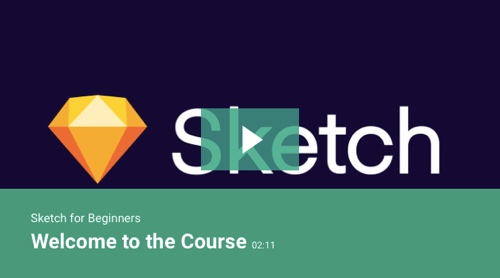
Sketch for Beginners




